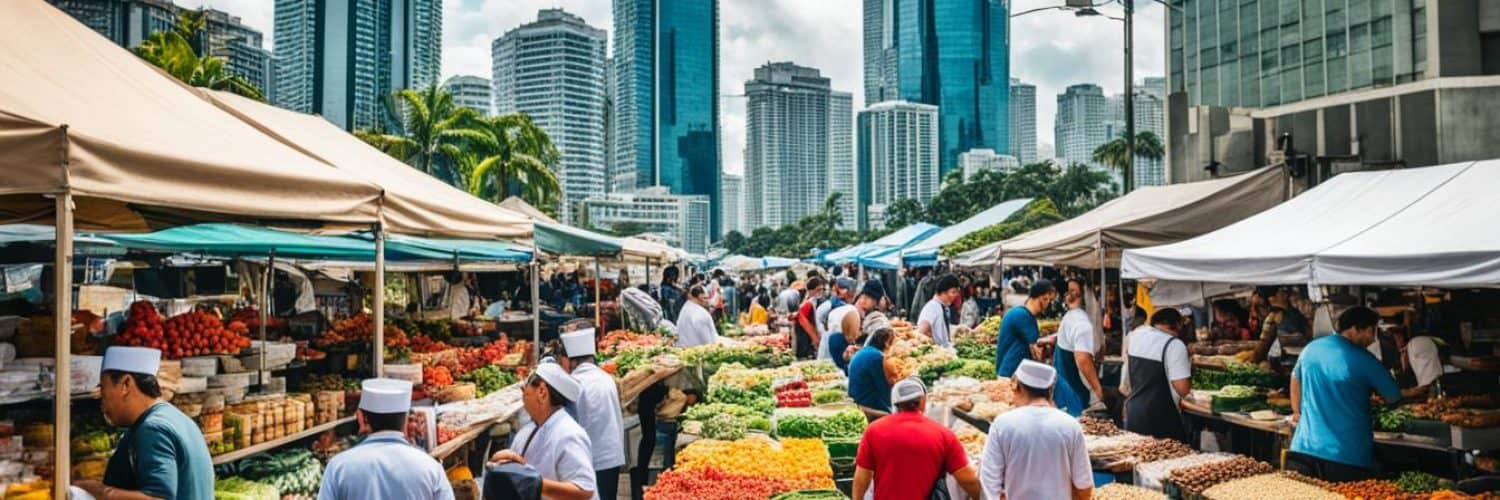Have you ever wondered what makes the Filipino food industry so unique and dynamic? Are you curious about the latest trends shaping the food business in the Philippines? Prepare to be amazed as we dive into the fascinating world of the Philippine food sector and uncover the insights and trends driving its growth.
Key Takeaways:
- The Philippine food industry is a vibrant and dynamic market offering growth opportunities for businesses.
- The rise in demand for healthy and functional food, plant-based options, and drinks with and without alcohol are some of the current trends in the Filipino food industry.
- Milk tea, gin, craft beer, and wine have gained popularity among Filipino consumers.
- Sustainability and convenience are key focuses in the Philippines, with businesses implementing eco-friendly practices and providing on-the-go options.
- The foodservice industry in the Philippines is projected to reach USD 31.47 billion by 2029, with quick service restaurants dominating the market.
Now, let’s delve deeper into the exciting world of the Philippine food industry and explore the trends that are shaping its future.
Healthy and Functional Food
The food and beverage industry in the Philippines is witnessing a significant shift towards healthier and more functional options. With an increasing number of health-conscious consumers, the demand for nutritious and delicious food is on the rise. To cater to these evolving preferences, trendy cafes and restaurants in Manila and other cities are now offering a variety of healthy choices such as salads, smoothie bowls, and vegan options.
One notable trend in the industry is the growing popularity of superfoods and alternative ingredients. Filipinos are embracing the goodness of superfoods and incorporating them into their diets for their nutritional benefits. Additionally, there is a renewed focus on traditional Filipino ingredients, promoting the concept of cooking traditional foods in healthier ways or substituting alternative ingredients to make them more nutritious.
“The demand for healthy and functional food is on the rise in the Philippines. Consumers are more health-conscious than ever and are actively seeking out options that not only taste great but also provide nutritional benefits. This presents an excellent opportunity for businesses to cater to this growing segment of health-conscious consumers.”
To provide a visual representation of the growing trends in healthy and functional food, below is a table showcasing some popular superfoods and alternative ingredients that are gaining popularity in the Philippines food and beverage industry:
| Superfoods | Alternative Ingredients |
|---|---|
| Quinoa | Cauliflower Rice |
| Chia Seeds | Flaxseeds |
| Kale | Malunggay (Moringa) |
| Goji Berries | Dried Local Berries |
| Turmeric | Turmeric Powder |
By embracing healthier options and incorporating superfoods and alternative ingredients, businesses in the food and beverage industry can capitalize on the growing demand for healthy and functional food in the Philippines. This not only provides consumers with a diverse range of choices but also promotes a healthier lifestyle in the country.
Plant Based Options
Filipinos are increasingly embracing plant-based diets and seeking out vegetarian or vegan alternatives. This growing demographic is driving the demand for plant-based food and beverages in the Philippines. Apart from catering to a specific consumer segment, these plant-based options also have a positive impact on the environment by reducing the carbon footprint associated with traditional animal-based products.
The Unilever Food Service report “Future Menus” highlights the opportunity for chefs to create plant-based alternatives of familiar favorites to meet the rising demand for plant-based options. For example, dishes like tofu and mushroom sisig provide a delicious and satisfying alternative to meat-based sisig while offering a healthier and more sustainable choice.
By embracing plant-based options, Filipinos can enjoy their favorite flavors and dishes while making choices that align with their health and environmental values.
Drinks, both with and without alcohol
Filipinos have an affinity for drinks, whether they come with or without alcohol. While craft beer, gin, and wine have gained popularity among those who appreciate unique flavors, there is also a rising demand for alcohol-free options. The sober conscious movement, coupled with the increasing popularity of kombucha, has contributed to the growth of the alcohol-free adult beverage market in the Philippines.
For those who enjoy a good cocktail without the alcohol, mocktails and zero-proof drinks provide an excellent alternative. These refreshing concoctions are carefully crafted to mimic the flavors and experience of traditional cocktails, without the buzz. Mocktails are becoming increasingly popular for individuals who prefer not to consume alcohol, but still want to enjoy a delicious and visually appealing beverage.

The sober conscious movement, along with the popularity of kombucha, has contributed to the growth of the alcohol-free adult beverage market in the Philippines.
Kombucha, a fermented tea-based beverage, has gained a devoted following among health-conscious individuals. This fizzy and tangy drink is not only delicious but also believed to have various health benefits. With its natural effervescence and probiotic properties, kombucha has become a favorite choice for those looking to make more mindful and health-conscious beverage choices.
Key Points:
- Filipinos enjoy both alcoholic and non-alcoholic drinks.
- Mocktails and zero-proof drinks cater to those who prefer not to consume alcohol but still want to enjoy flavorful and visually appealing beverages.
- The rising popularity of the sober conscious movement and kombucha has contributed to the growth of the alcohol-free adult beverage market in the Philippines.
Milk Tea
The milk tea craze has taken the Philippines by storm. Milk tea shops are popping up everywhere, and Filipinos of all ages can’t seem to get enough of this refreshing beverage. Chains such as Gong Cha, Cha Time, and Macao Imperial Tea have become popular destinations for milk tea lovers. Despite the growing interest in healthier options, lower sugar options haven’t gained as much traction in the milk tea market.
The Milk Tea Phenomenon
Milk tea, a blend of tea, milk, and various toppings, has become a favorite among Filipinos seeking a delightful and satisfying drink. With its combination of flavors and textures, milk tea provides a refreshing and indulgent experience.
“Milk tea shops in the Philippines are more than just places to get a drink. They have become spaces for people to relax, socialize, and enjoy their favorite milk tea concoctions.”
The popularity of milk tea can be attributed to its versatility and the ability to customize flavors and sweetness levels. From classic flavors like jasmine and black tea to innovative blends like matcha and fruit-infused teas, there is a milk tea flavor for every palate.
The Rise of Milk Tea Shops
Gong Cha, Cha Time, and Macao Imperial Tea are leading milk tea chains in the Philippines, offering a wide range of flavors and toppings to satisfy different cravings. These milk tea shops have quickly expanded across the country, providing convenient and accessible options for milk tea enthusiasts.
| Milk Tea Chains | Number of Outlets |
|---|---|
| Gong Cha | 100+ |
| Cha Time | 80+ |
| Macao Imperial Tea | 60+ |
Emerging Milk Tea Trends
In addition to classic milk tea flavors, innovative and seasonal variations have also gained popularity. Some notable trends in the milk tea scene include:
- Fruit-infused teas: Fresh fruit flavors like strawberry, mango, and lemon are added to milk tea for a burst of natural sweetness.
- Taro milk tea: Made from the root vegetable taro, this milk tea flavor offers a unique, earthy taste.
- Oat milk tea: This dairy-free alternative is rising in popularity, catering to those with lactose intolerance or dietary restrictions.
As milk tea continues to captivate Filipino taste buds, the industry is constantly evolving, introducing new flavors and unique combinations to keep customers coming back for more.
Gin
The Philippines boasts the largest gin market in the world, accounting for a staggering 43% of global consumption by volume. Gin, particularly the locally produced Ginebra San Miguel, is not only incredibly affordable but also widely enjoyed throughout the country. While traditional flavors such as juniper and citrus remain the most popular, Filipino consumers are also open to exploring new and exciting flavors.
With its vast consumer base and growing appreciation for gin, the Philippine market presents an opportunity for premium brands to make their mark. Although competition is fierce, the demand for high-quality gin allows premium brands to carve out their niche and cater to discerning Filipino gin enthusiasts.
To illustrate the dominance of the gin market in the Philippines, take a look at the following table:
| Country | Volume Consumed | Market Share |
|---|---|---|
| Philippines | 2.7 billion liters | 43% |
| United States | 815 million liters | 13% |
| Spain | 732 million liters | 12% |
| United Kingdom | 468 million liters | 7% |
| Germany | 316 million liters | 5% |
As the table above demonstrates, the gin market in the Philippines is truly unparalleled, overshadowing the consumption in other countries. With such impressive volumes consumed, it’s clear that the Philippine gin market holds enormous potential for both domestic and international brands to expand their reach and capitalize on the country’s love for this spirit.
Craft Beer
As the craft beer movement gains momentum in the Philippines, microbreweries are popping up across the country, offering unique and flavorful brews to beer enthusiasts. Local brands like Pedro Brewcrafters and Engkanto have gained popularity, showcasing their expertise in creating artisanal beers.
However, while local craft beer brands continue to flourish, there is still room for imported craft beer to make its mark on the Filipino market. Imported brands bring a diverse range of flavors and styles, providing beer lovers with even more options to explore and enjoy.
One of the challenges faced by imported craft beer brands in the Philippines is price competitiveness. The excise on alcohol makes it difficult for imported beers to compete on price with their local counterparts. Nevertheless, the appeal of imported craft beers lies in their unique brewing techniques, distinct flavors, and the story behind each brand.
“Craft beer brings an exciting and distinct taste experience to beer enthusiasts in the Philippines. The local craft beer scene is thriving, but there is still room for imported brands to make a mark. The challenge lies in finding the right balance between quality and price competitiveness, considering the excise on alcohol.”
The Rise of Microbreweries
Microbreweries are at the forefront of the craft beer movement in the Philippines, brewing small batches of beer with meticulous attention to detail. These local matadors are constantly experimenting with different ingredients and techniques, pushing the boundaries of traditional brewing methods.
- Their commitment to quality and creativity has garnered a loyal following among beer enthusiasts, who appreciate the unique flavors and character that craft beer offers.
- Microbreweries often serve as community gathering spaces, where beer lovers can connect with like-minded individuals and share their passion for finely crafted brews.
- These establishments also contribute to the local economy by supporting local farmers and suppliers, sourcing ingredients locally whenever possible.
Exploring Imported Craft Beer
While the local craft beer scene is thriving, imported craft beer offers a different experience for beer enthusiasts in the Philippines. Imported brands bring a global perspective to the craft beer landscape, showcasing brewing traditions and techniques from around the world.
“Imported craft beers offer a window to the world of brewing, allowing Filipinos to explore different beer styles and flavors. Whether it’s a refreshing IPA from the United States or a rich stout from Belgium, imported craft beers broaden the horizons of beer enthusiasts and provide a taste of international brewing excellence.”
With their innovative recipes and distinct labels, imported craft beer brands add diversity to the beer market in the Philippines. These beers often come with a story, highlighting the craftsmanship and passion that goes into each brew.
Price Competitiveness
The challenge of price competitiveness arises due to the excise on alcohol, which affects the overall cost of imported craft beer in the Philippines. While imported craft beer may have a higher price point compared to local brands, beer enthusiasts are willing to pay for the unique and premium experience it offers.
Despite the pricing challenges, imported craft beer brands continue to find their niche in the Filipino market. Some beer enthusiasts are willing to splurge on their favorites, appreciating the craftsmanship and quality that sets these beers apart.
For breweries looking to enter the Philippine market, finding the right balance between quality and price competitiveness is crucial. By understanding the local demand and offering a range of options at different price points, imported craft beer brands can carve out a space for themselves in the diverse and growing craft beer scene in the Philippines.

“The excitement and enthusiasm surrounding craft beer in the Philippines create a thriving environment for both local and imported brews. The craft beer movement continues to captivate beer enthusiasts, offering a wide array of flavors and styles. While the excise on alcohol presents challenges, craft beer enthusiasts are passionate about exploring the rich and diverse world of beers, both local and imported.”
Wine
Despite the challenges of importing wine, there is a growing interest in wines in the Philippines. Wine producers have received inquiries from the Philippines, indicating the potential for growth in the wine market. Filipino consumers are becoming more open to trying different wines, presenting an opportunity for wine producers.
| Type of Wine | Description |
|---|---|
| Red Wine | Red wines are known for their rich flavors and aromas, with popular varieties including Cabernet Sauvignon, Merlot, and Pinot Noir. |
| White Wine | White wines are often refreshing and crisp, with popular varieties such as Chardonnay, Sauvignon Blanc, and Riesling. |
| Rose Wine | Rose wines offer a balance between the fruity flavors of red wine and the lightness of white wine, making them a popular choice for many consumers. |
| Sparkling Wine | Sparkling wines, including Champagne and Prosecco, add a touch of celebration to any occasion with their effervescence and distinct flavors. |
Whether it’s pairing wine with local cuisine or enjoying it on its own, wine has become a popular choice for Filipinos looking to enhance their dining experience. Wine enthusiasts and connoisseurs are exploring different regions and grape varieties, creating opportunities for wine producers to expand their presence in the Philippine market.
“Wine is the perfect companion to elevate your dining experience. From the subtle flavors of a Pinot Noir to the crisp notes of a Chardonnay, there is a wine to suit every taste and occasion.”
To capture the growing interest in wines, wine producers can focus on educating Filipino consumers about the different wine varieties, their origins, and suitable food pairings. This knowledge can empower consumers to make informed choices and create memorable experiences with wine.
Sustainability
Sustainability is at the forefront of the food and beverage industry in the Philippines. As consumers become more environmentally conscious, businesses that prioritize eco-friendly practices and implement sustainable measures are gaining support and loyalty.
One key aspect of sustainability is the use of eco-friendly packaging. Many businesses are transitioning to biodegradable packaging materials, reducing the environmental impact of single-use plastics.
Another sustainable practice embraced by the industry is local sourcing. By supporting local farmers and suppliers, businesses not only reduce their carbon footprint by minimizing transportation distances but also contribute to the growth and development of local communities.
Reducing food waste is also a critical component of sustainability efforts. Many businesses are implementing measures to minimize food waste throughout their operations, such as implementing efficient inventory management systems and donating surplus food to local charities.
Implementing sustainable logistics practices is another important step in promoting sustainability. Businesses are exploring eco-friendly transportation options, optimizing delivery routes, and using energy-efficient technologies to reduce their impact on the environment.
Opportunities for Vertical Farming, Lab-Grown Meat, and Alternative Proteins
In line with the sustainability movement, there are exciting opportunities for innovative projects in the Philippines. Vertical farming, for example, offers a sustainable solution to urban agriculture by utilizing limited space efficiently and reducing the need for pesticides and herbicides.
Another emerging trend in sustainability is the development of lab-grown meat and alternative proteins. These technologies have the potential to revolutionize the food industry, providing environmentally friendly alternatives to traditional animal agriculture. They offer a more sustainable way to meet the growing demand for protein without relying on resource-intensive practices.
By embracing sustainability and adopting eco-friendly practices, the food and beverage industry in the Philippines can pave the way for a greener and more sustainable future, satisfying not only the growing demand for sustainable products but also contributing to the preservation of our planet.
Swicy – The Sweet and Spicy Flavor
Filipinos have a deep appreciation for the unique taste combination of sweet and spicy flavors, which they affectionately call “swicy.” This fusion flavor can be found in various dishes and snacks, adding an exciting twist to traditional Filipino cuisine. The popularity of Korean cuisine, renowned for its harmonious blend of sweet and spicy flavors, has further fueled the demand for swicy dishes in the Philippines.
The combination of sweetness and spiciness in swicy dishes creates a delightful contrast that tantalizes the taste buds. It offers a sensory experience that is both bold and captivating, providing a truly unique flavor profile for food enthusiasts to explore. Swicy dishes have gained a devoted following among Filipinos, who appreciate the explosion of flavors and the way they elevate traditional Filipino favorites.
“The fusion of sweet and spicy flavors in swicy dishes brings a whole new dimension to Filipino cuisine, creating a memorable taste experience that keeps people coming back for more.”
Restaurants and food establishments across the country have embraced the swicy trend, incorporating these flavor combinations into their menus. From swicy chicken to swicy noodles and even swicy snacks, there are endless possibilities to satisfy cravings for this unique taste sensation.
Examples of Swicy Dishes
| Dish | Description |
|---|---|
| Swicy Chicken | Tender chicken coated in a sweet and spicy glaze, offering a perfect balance of flavors. |
| Swicy Tteokbokki | A traditional Korean dish of chewy rice cakes cooked in a swicy sauce, creating a delightful blend of textures and flavors. |
| Swicy Pork BBQ | Mouthwatering barbecue pork marinated in a swicy sauce, delivering a harmonious combination of sweetness and spiciness. |
The growing popularity of swicy dishes highlights the adventurous palate of Filipino consumers. This flavor profile has not just remained confined to Korean cuisine, but has also been embraced in various fusion dishes, showcasing the versatility and innovation within the Filipino food scene.

This image visually captures the essence of swicy, showcasing a delectable dish that perfectly encapsulates the unique taste combination of sweet and spicy flavors.
New Ingredients
The Philippines is known for its rich and diverse culinary traditions, constantly pushing the boundaries of flavor and innovation. Filipino food enthusiasts are always eager to explore new ingredients, embracing exotic fruits, lesser-known herbs, and international flavors to create dishes that tantalize the taste buds and inspire culinary adventure.
“Filipinos have a deep appreciation for bold and vibrant flavors, and we are constantly on the lookout for new ingredients that can elevate our traditional dishes,” says Chef Isabel Cruz, a renowned Filipino chef based in Manila. “The exploration of new ingredients allows us to add excitement and diversity to the food and beverage scene in the Philippines.”
When it comes to incorporating new ingredients, Filipinos are particularly fond of experimenting with exotic fruits. From the tangy sweetness of mangoes to the unique tartness of dragon fruit, the vibrant flavors of these fruits add a tropical twist to both sweet and savory dishes.
Alongside exotic fruits, lesser-known herbs play a crucial role in expanding the culinary repertoire of Filipinos. Herbs like lemongrass, pandan, and kaffir lime leaves lend their distinct aromas and flavors to traditional Filipino dishes, infusing them with a touch of freshness and complexity.
Furthermore, the exploration of international flavors has become increasingly popular in the Philippines. Filipino food enthusiasts are embracing dishes from cuisines around the world, such as Thai, Korean, and Mexican, and infusing them with local ingredients and techniques to create exciting fusion dishes.
“The incorporation of international flavors allows us to broaden our culinary horizons and create unique taste combinations,” explains Chef Cruz. “By blending international flavors with local ingredients, we can redefine traditional Filipino dishes and introduce new and exciting flavors to our diners.”
The exploration of new ingredients in the Philippines showcases the country’s culinary creativity and its willingness to embrace diversity. It offers an opportunity for chefs, home cooks, and food enthusiasts to expand their culinary knowledge and expertise while also satisfying the adventurous palates of Filipinos. Incorporating new ingredients not only adds an element of surprise and innovation to Filipino cuisine but also contributes to the preservation and promotion of local and international culinary traditions.
Convenience
Convenience is the key for busy Filipinos who are always on the go. Whether it’s a quick snack or a satisfying meal, they appreciate food and beverages that offer both taste and convenience. With the fast-paced lifestyle in the Philippines, companies that provide on-the-go options that are delicious and easy to consume can win the hearts of busy Filipino consumers.
When it comes to satisfying their cravings, Filipinos can now rely on delivery apps like GrabFood and FoodPanda. These convenient platforms have gained popularity, allowing consumers to enjoy their favorite foods in the comfort of their own homes. With just a few taps on their smartphones, they can have a wide selection of delicious meals and snacks delivered right to their doorstep.
To cater to the on-the-go lifestyle of Filipinos, many food establishments have also made it a point to offer portable and easy-to-eat options. From handy sandwiches and wraps to grab-and-go salads and bowls, there are plenty of choices for those who need a quick and satisfying meal without compromising on taste.
Here are some key reasons why convenience is a top priority for busy Filipinos:
- Time-saving: With hectic schedules and long commutes, Filipinos value time-saving options that allow them to enjoy a delicious meal without spending too much time preparing or waiting for it.
- On-the-go options: Portable and easy-to-eat options are highly sought after, allowing busy individuals to enjoy their meals while on the move or during a short break.
- Delicious and easy to consume: Convenience doesn’t mean sacrificing flavor. Filipinos appreciate food and beverages that are not only convenient but also delicious and satisfying.
- Delivery apps: The rise of delivery apps has revolutionized the way Filipinos enjoy their meals. These apps provide a seamless and convenient way to order food, making it accessible to anyone, anytime.
With the growing demand for convenience, businesses in the food and beverage industry in the Philippines should consider incorporating on-the-go options into their offerings. By ensuring that these options are not only convenient but also delicious and easy to consume, they can tap into the busy Filipino market and cater to their needs.
Market Size and Growth
The Philippine foodservice industry is experiencing significant growth, with promising market trends and key players driving the industry forward. The market size is projected to reach a staggering USD 31.47 billion by 2029, growing at an impressive CAGR of 14.32%. This substantial growth presents numerous opportunities for businesses looking to enter or expand their presence in the vibrant Filipino food market.
Trends Driving the Market
- The rise of quick service restaurants (QSRs) has catapulted them to dominance in the foodservice industry. Offering convenient, affordable, and fast dining experiences, QSRs cater to the on-the-go lifestyle of busy Filipinos.
- Full-service restaurants continue to capture a significant share of the market, delivering exceptional dining experiences and personalized service to customers across the country.
Key Players
The Philippine foodservice industry boasts a roster of major players that have shaped the market and enjoyed substantial success. These key players include:
- Golden Arches Development Corporation: Known for its iconic fast-food chain, McDonald’s, the company has established itself as a household name in the Philippines, with numerous locations nationwide catering to a diverse range of customers.
- Jollibee Foods Corporation: Considered one of the largest and fastest-growing Asian restaurant companies, Jollibee is a beloved Filipino brand that offers a wide range of dining experiences, including fast food, casual dining, and more.
- Seven & I Holdings Co., Ltd.: This multinational retail and consumer goods company operates several well-known brands, including 7-Eleven, a popular destination for convenient food and beverages.
- Starbucks Corporation: Recognized globally for its premium coffee offerings and cozy ambiance, Starbucks has made a significant impact on the Philippine market, attracting a loyal customer base.
- Yum! Brands, Inc.: As the parent company of renowned fast-food chains such as KFC and Pizza Hut, Yum! Brands has a strong presence in the Philippine market, offering a wide variety of flavorful options to satisfy a diverse range of palates.
Market Insights
With its robust growth, the Philippine foodservice industry presents ample opportunities for businesses and investors. To succeed in this market, companies need to stay ahead of market trends, understand the evolving preferences of Filipino consumers, and provide innovative and high-quality dining experiences. By leveraging market insights and aligning their strategies with the evolving landscape, businesses can position themselves for success and contribute to the dynamic growth of the foodservice industry in the Philippines.
Key Players in the Market
The Philippine food industry is driven by several major companies that play a vital role in its growth and development. These key players have established themselves as industry leaders, with a strong presence and a significant market share. Let’s take a closer look at three prominent companies in the food industry:
Golden Arches Development Corporation (McDonald’s)
| Company Name | Key Information |
|---|---|
| Golden Arches Development Corporation | Golden Arches Development Corporation, known as McDonald’s Philippines, is a subsidiary of McDonald’s Corporation. The company operates numerous McDonald’s outlets across the country, making it one of the most recognized and successful fast-food chains in the Philippines. Its extensive menu, strong brand presence, and commitment to quality have contributed to its ongoing success in the market. |
Jollibee Foods Corporation
| Company Name | Key Information |
|---|---|
| Jollibee Foods Corporation | Jollibee Foods Corporation is a leading Filipino multinational chain of fast food restaurants. The company operates Jollibee, a well-loved and iconic Filipino fast-food brand that offers a range of delicious and affordable meals. Jollibee’s strong brand loyalty and continuous innovation have propelled it to become a market leader in the Philippines, with a growing presence in other countries. |
Starbucks Corporation
| Company Name | Key Information |
|---|---|
| Starbucks Corporation | Starbucks Corporation is a globally renowned coffeehouse chain that has gained immense popularity in the Philippines. With its inviting ambiance, high-quality coffee, and an extensive menu of food and beverages, Starbucks has become a favorite gathering place for Filipinos. The company’s commitment to sustainability and community engagement has further solidified its position as a key player in the Philippine food industry. |
These key players in the food industry are instrumental in shaping the market and meeting the diverse preferences of Filipino consumers. They continue to innovate and adapt their offerings to stay competitive and maintain their stronghold in the industry.
Conclusion
The food industry in the Philippines presents a wealth of opportunities for businesses looking to expand their reach and tap into a vibrant and growing consumer market. By keeping a finger on the pulse of the latest trends and tailoring their offerings to the Filipino market, companies can position themselves for success.
One key aspect to consider is the export opportunities that the Philippines offers. With its diverse range of trends, including healthy and functional food, sustainability, and unique flavor combinations, businesses can create products that cater to the preferences of Filipino consumers and also appeal to international markets.
Joining the food and beverage scene in the Philippines means immersing in a dynamic market that welcomes innovation and embraces new concepts. By embracing the local food culture and incorporating elements that resonate with Filipino tastes, businesses can establish a strong foothold in this vibrant industry.
Success in the Philippine market requires a deep understanding of the unique preferences and demands of Filipino consumers. By delivering high-quality products, leveraging the latest trends, and focusing on sustainability, businesses can attract and retain a loyal customer base, driving growth and long-term success in the Philippine food and beverage industry.














Add comment